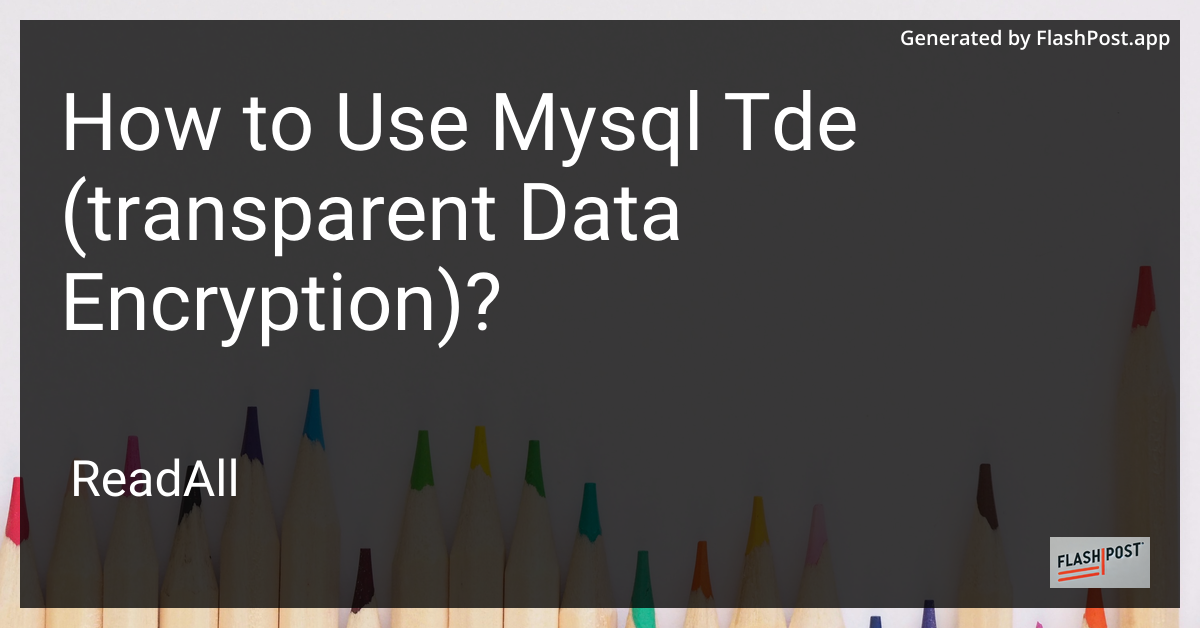
Best MySQL Books to Buy in 2025
| Product | Features | Price |
|---|---|---|
 MySQL Crash Course: A Hands-on Introduction to Database Development |
Shop Now  |
|
 Murach's MySQL (4th Edition) Professional SQL Book & Reference Guide with Cheat Sheets - Complete Database Development Training for Retrieving, Updating & Managing Data with AWS Integration |
Shop Now  |
|
 PHP & MySQL: Server-side Web Development |
Shop Now  |
|
 Learning MySQL: Get a Handle on Your Data |
Shop Now  |
|
 Efficient MySQL Performance: Best Practices and Techniques |
Shop Now  |
Data security is a top priority for businesses and individuals alike. With the growing risk of data breaches, protecting sensitive information stored in databases has become more crucial than ever. MySQL Transparent Data Encryption (TDE) is a powerful feature that helps encrypt data at rest, ensuring unauthorized access is prevented. This article will guide you through the steps to effectively use MySQL TDE to secure your data.
What is MySQL TDE?
MySQL Transparent Data Encryption (TDE) allows for the encryption of tablespaces, providing an easy way to secure data stored within a MySQL database. It ensures that data is encrypted on disk and decrypted when loaded into memory, offering a seamless experience for applications and users.
Prerequisites
-
MySQL version 5.7.11 or higher is required for TDE support. If you are using an older version, consider upgrading. Learn how to upgrade MySQL to a new version.
-
Root or administrative access to the MySQL server for configuring and enabling encryption settings.
-
Active backup strategy to ensure data safety should anything go wrong.
Step-by-Step Guide to Using MySQL TDE
Step 1: Verify MySQL Version
Make sure you are running a compatible MySQL version. Execute the following command to check your current version:
SELECT VERSION();
Step 2: Configure InnoDB for Encryption
Before using TDE, enable InnoDB settings for encryption. Add the following lines to your my.cnf or my.ini configuration file:
[mysqld] early-plugin-load=keyring_file.so keyring_file_data=/var/lib/mysql-keyring/keyring
Step 3: Restart MySQL Server
Restart the server to apply the changes:
For Linux:
sudo service mysql restart
For Windows:
net stop mysql net start mysql
Step 4: Create Keyring and Set the Master Key
Create a master encryption key using the mysql command-line client:
ALTER INSTANCE ROTATE INNODB MASTER KEY;
Step 5: Encrypt Tablespaces
Identify the tablespaces you wish to encrypt and execute the following command:
ALTER TABLE your_table_name ENCRYPTION='Y';
Step 6: Verify Encryption
You can verify that the tablespace is encrypted by executing:
SELECT * FROM information_schema.tables WHERE table_schema='your_database_name' AND table_name='your_table_name';
Check that the ENCRYPTION column for the specified table returns Y.
Best Practices
- Regularly rotate the master key to enhance security.
- Backup keys securely, mirroring your data backup strategy.
- Consider the benefits of MySQL stored procedures for performance optimization.
- Use synchronized backups, as encrypted data has a different strategy than non-encrypted backups.
Additional Resources
- For scenarios requiring data conversion, explore MySQL date to hexadecimal conversion.
By following these steps, you’re on your way to securing your MySQL database with Transparent Data Encryption. Ensuring data protection not only safeguards sensitive information but also fosters trust and compliance with modern data privacy standards.